Home Body
| « NVMe clamp for camera rig | DWELL on your anxieties » |
Our first-ever real (more than a minute long) short film is here!
This is the "director's cut" of our submission to the 48 Hour Horror Film Project in Seattle: it adds everything I didn't have time for originally (a score, color grading, and better sound effects) and makes one or two minor edit tweaks.
I'm still really proud of what we originally submitted and we were happy and surprised to learn that we won some awards among a pool of sixteen submissions:
- Winner for Best Editing
- Winner for Best Acting in a Comedy for Robin Klevansky (Molly)
- 2nd Place for Best Film
- Runner-up for Best Writing (which is particularly charming since most of the movie is improvised)
- Runner-up for Best Direction
- Runner-up for Best Cinematography
Since it's COVID times, we put this with a crew consisting of everyone in our house, our COVID Coven™ friends as extras/PA's, and a friend of the family over Zoom for the initial writing session:
- Sarah Giese: Director, writer, actor (Moonshadow Jones), production design
- Robin Giese (i.e. me): Executive producer, writer, cinematographer, editor, colorist, composer
- Robin Klevansky: Producer, writer, actor (Molly)
- Peter Schaefer: Writer, cast (extra), production assistant
- Madeleine Geraghty: Writer
- Beth Drummond, Zach Drummond, Micah Drummond, Zander Drummond, Harry Giese, Oliver Giese: Cast (extras), production assistants
In case you can't get YouTube working above, here's the thumbnail for the official video: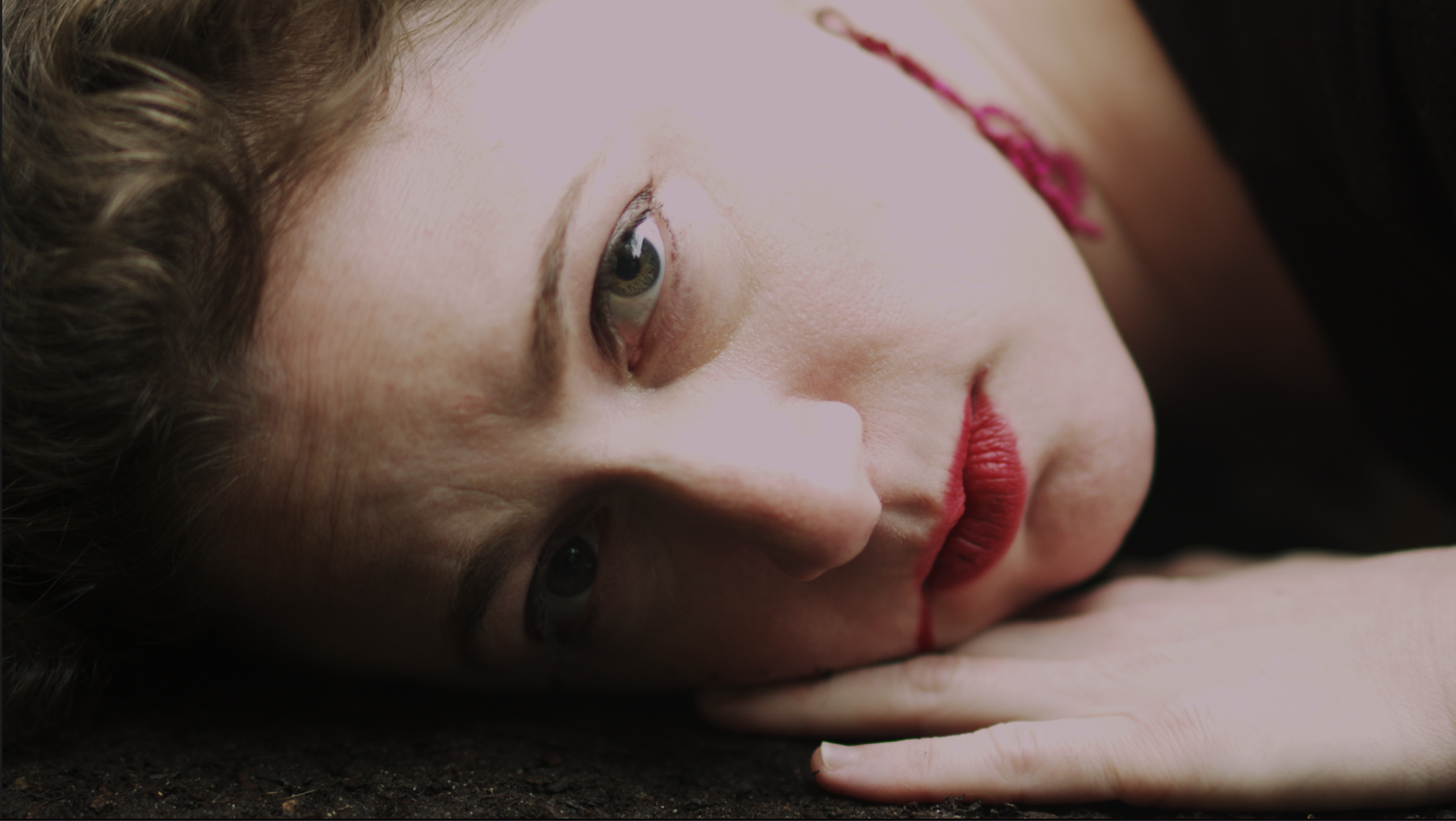
So, here's how it all went down. (Note: contains spoilers.)
Prep work
Learning about horror
I had proposed that we enter the Horror category of the film festival because none of us in the house are horror people so this put every one of us on even ground, genre-wise. It's also fun to do something new, though admittedly this is also our first time making any kind of movie that's longer than a minute long so we're not exactly short on novelty. Anyhow.
In the weeks before the 48 we went off to watch ("research") a bunch of horror films (both feature-length and shorts) under the guidance of our friends Madeleine (one of our writers) and Brieanne, both actual horror buffs.
My main take-away was that the beauty of a horror movie is that it just needs to take you on an emotional journey that makes enough sense to get you from plot point to plot point without having to ever explain the entire mechanism.
I also loved how much of the story you can tell with visuals, sound, and music rather than having to say everything. That's a general film thing, of course, but it seems especially true in horror. (And yes, it's a bit ironic then that I didn't have time to create any music in those 48 hours. Alas.)
Gear
I'm tremendously grateful to my friend Russell for loaning us his Ursa Mini Pro 4.6K camera. I did not expect to shoot anything with a two-camera setup but having the flexibility to do that for one of our setups ended up being a massive timesaver.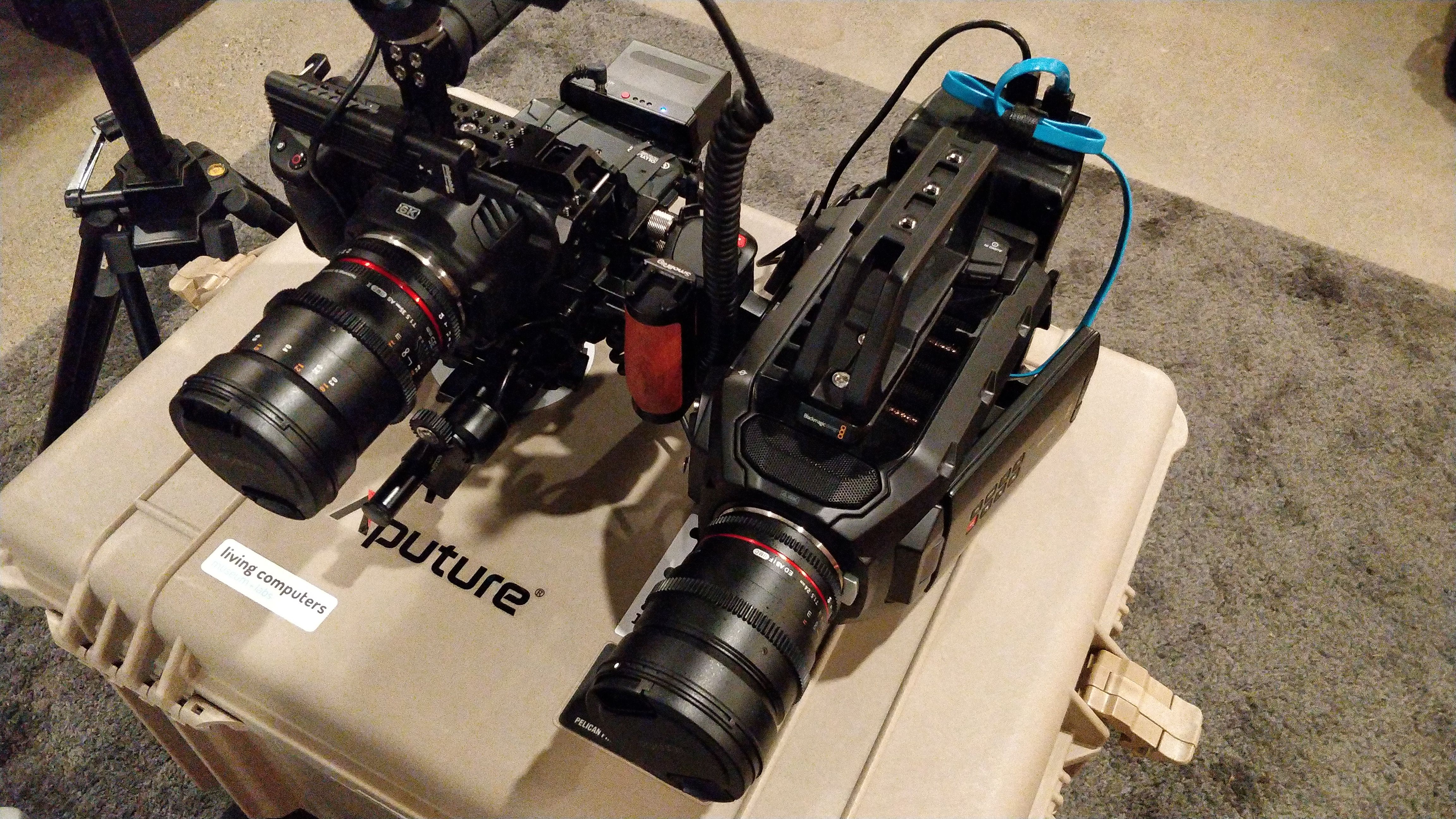
I also rented an Easyrig vest (for sort-of Steadicam-ish shots) and two extra lights through ShareGrid.
Friday, October 16th 2020
6:57pm
The 48 Hour Horror Film Project staff announces this year's requirements. Every film must feature:
- A required character: Moonshadow Jones, with the occupation of Virtual Healer (whatever that may mean).
- A required prop: an onion.
- A required line: Nope. Just nope. Nope, nope, nope. Very nope.
Each team is also assigned two genres that their film needed to adhere to (one or both); ours are dark comedy and phobia/isolation.
7:00pm (48.5 hours remaining)
The writer's room starts. The clock is ticking - the film must begin uploading by 7:30pm on Sunday, just over 48 hours away.
7:10pm (48.3 hours remaining)
The writer's room actually starts as people finally trickle in, Zoom starts working, and so on.
At this point anything is possible (we could make a film in the forest, in a car, ...) and that's always a tough spot to be in creatively - too many possibilities make for too much work.
We debate what the required items even mean (e.g. what a "virtual healer" is), which of the two genre options we want to lean into, and how concrete vs. absurdist we want to be (e.g. what if a character is mortally afraid of ducks?).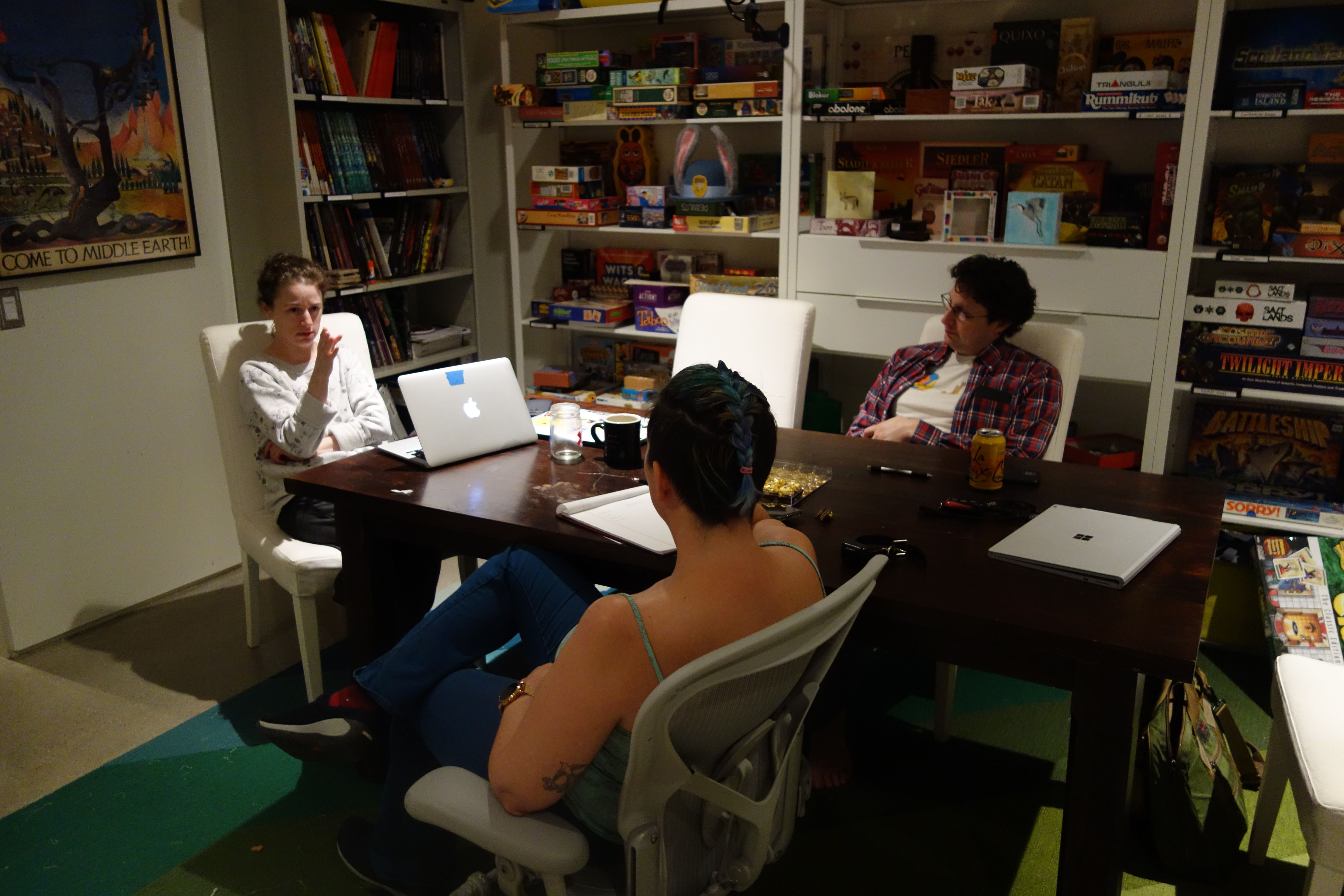
9:00pm (46.5 hours remaining)
An idea gels around a house-bound character who starts watching a woo-woo healer channel on YouTube after which weird things start happening. It's both dark comedy (with the framing/ending we had in mind) and a phobia/isolation thing so we're even hitting both genre options.
We look around the table and decide that Robin (Klevansky, not me) would be a great house-bound anxiety sufferer and Sarah would be a great woo-woo healer. We didn't really expect Robin to pick up her first-ever acting gig that night but hey, it's a 48, you work with what you got (and she ended up winning an award for it!).
We've determined that our good friends, the Drummond clan, can help out as extras for one of the scenes, so we activate them and ask them to show up at 11am the next morning.
With our movie cast, we take a short break and then figure out the main beats and turning points in our story.
From time to time I take a break from the writer's room to build out my DaVinci Resolve project for editing, assemble the required opening sequence, and put together the end credits now that we know who's doing what.
11:00pm (44.5 hours remaining)
We now know what story we want to tell and where we're going to tell it (our house, thankfully, no location travel needed). The beats of the story create four plot days, each starting the same way but going progressively worse for our protagonist. This gives us some nice structure to hang exposition off of in an Edgar Wright-ish way and it makes the whole process easier to organize as well.
It's time to plan some cinematography.
First we pick the locations where we're going to shoot (the kitchen, the entry, etc.) and draw top-down diagrams of where characters and cameras should be. Next, we write each shot on an index card (location, shot type, what happens) and tape it to the big glass door in the writer's room. We re-arrange cards as needed, adding and removing shots as we go, and marking some as "nice to haves". We talk through it a couple of times to test the pacing.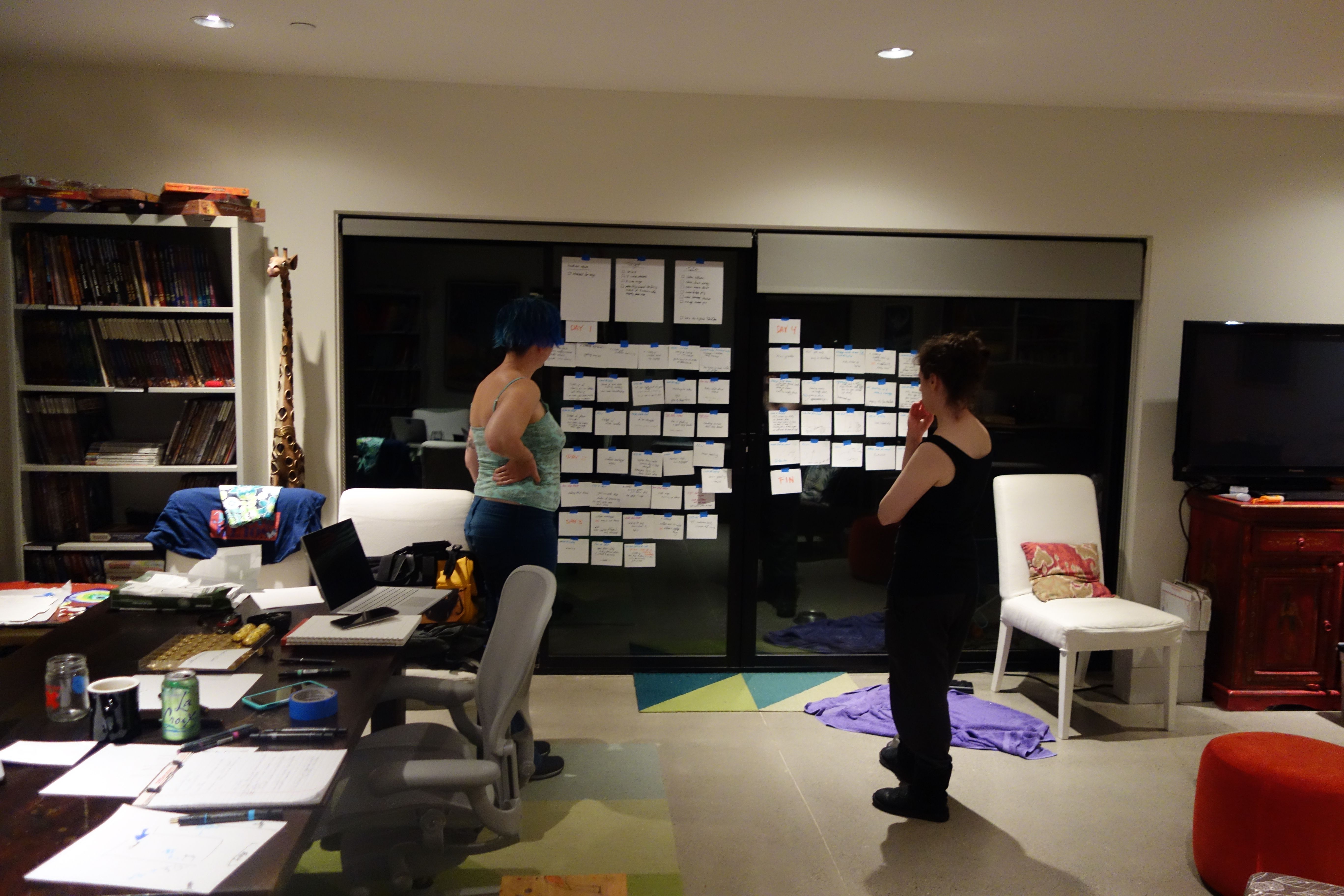
Note that at this point we haven't actually written any of the lines, and it turns out we never will. Because there's so few of us (with Sarah, Robin, and myself being the core cast and crew) we can keep it in our heads and improvise everything as we go under each other's direction. I think this helped us get nice organic lines and interactions since we could just everything on the fly by feel.
12:00am (43.5 hours remaining)
We have decided that the back-and-forth between Sarah (Moonshadow Jones) on YouTube and Robin (Molly) in front of the laptop will happen entirely in the editing room: we're going to record Robin first with a two-camera setup (over-the-shoulder and across) and film Sarah's part later and greenscreen her in. (We've never greenscreened anything before.) We just don't have the time to film Sarah first.
We number the shot cards and it's a bit scary: 52 shots plus all the Moonshadow work, six shooting areas, eighteen different setups. This is not a good idea to put it mildly but we're gonna do it anyways.
1:00am (42.5 hours remaining)
We re-arrange the shot cards by setup and sequence out how the next day is going to run. Now we sleep.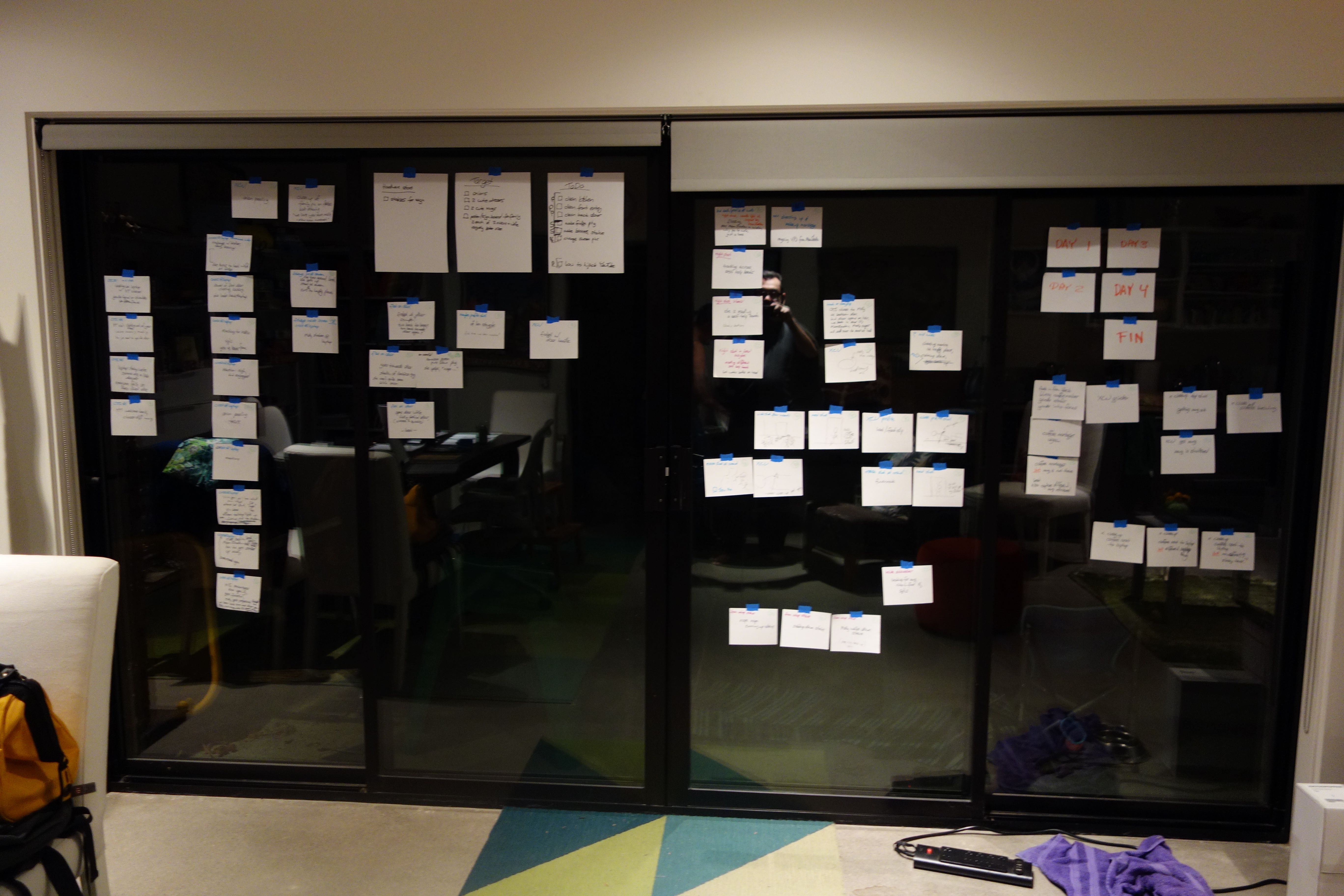
Saturday, October 17th 2020
7:30am (36 hours remaining)
Time for coffee.
First up: paperwork. If there's anything I've learned from the live shows I've worked on it's that good paperwork makes or breaks an event, especially if it's high-pressure and fast-paced.
I create a Google Sheets doc listing each shot that I can order by shot (for editing purposes) and setup (for planning and filming purposes).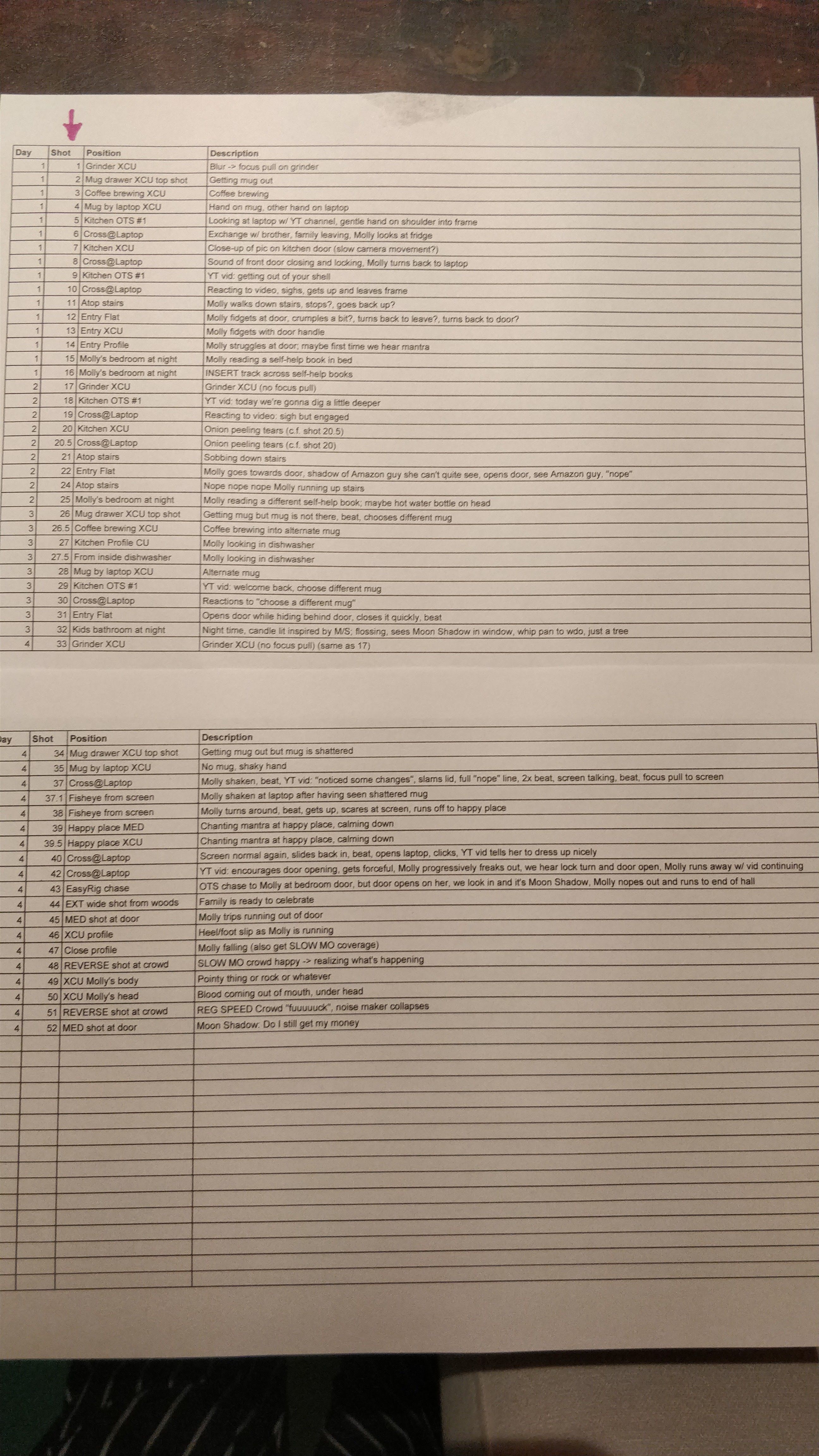
I also create and print a page per shot from a Google Docs template. It includes the shot number, setup, plot summary, and per-take information to be filled in while filming. This had all seemed like a better idea when Robin was going to be my Assistant Director instead of main cast member but it still proved useful for me to have something to scribble on while filming.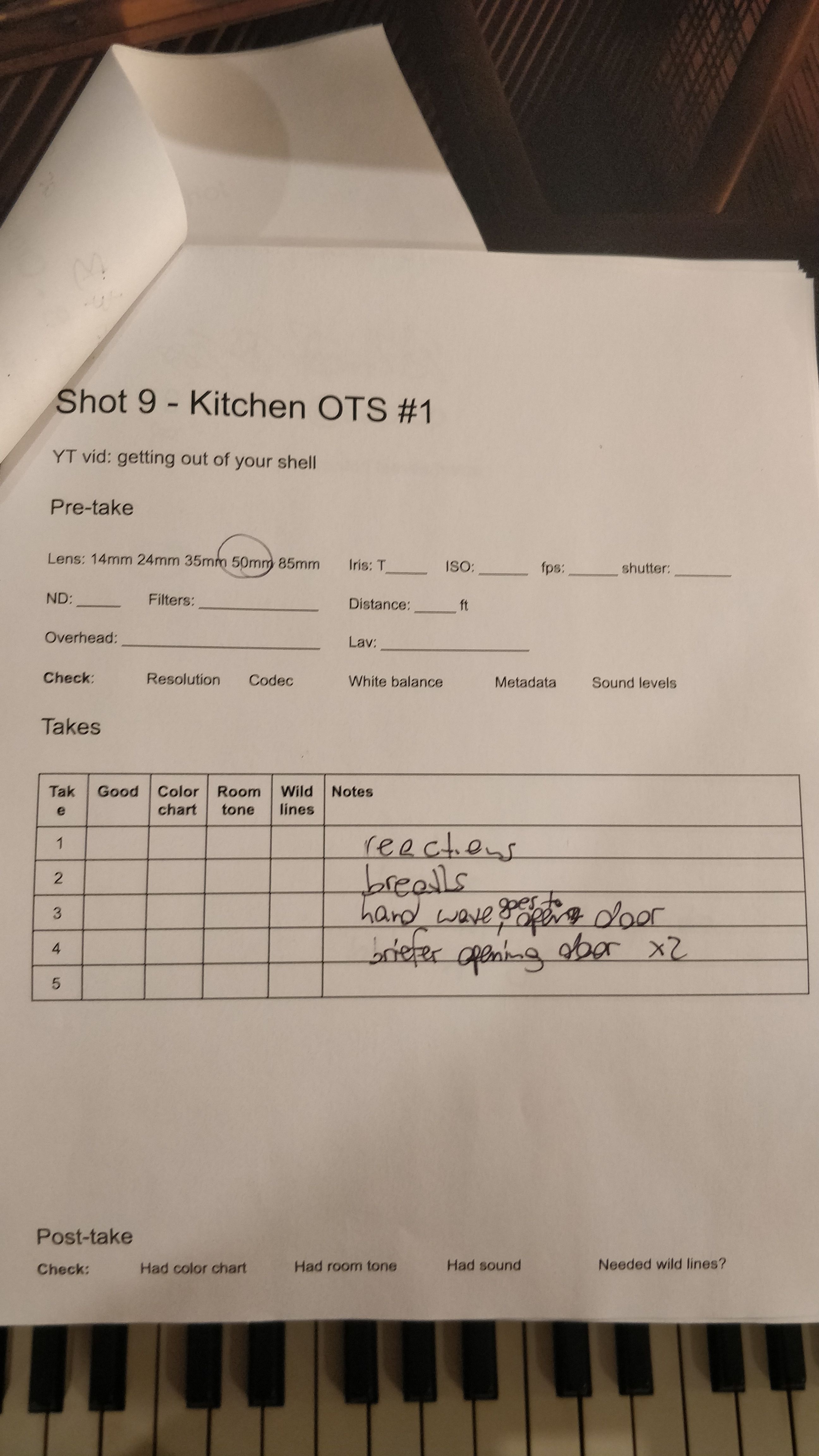
Each location gets its shot pages stapled together into packets so I don't need to lug the entire thing around all day long.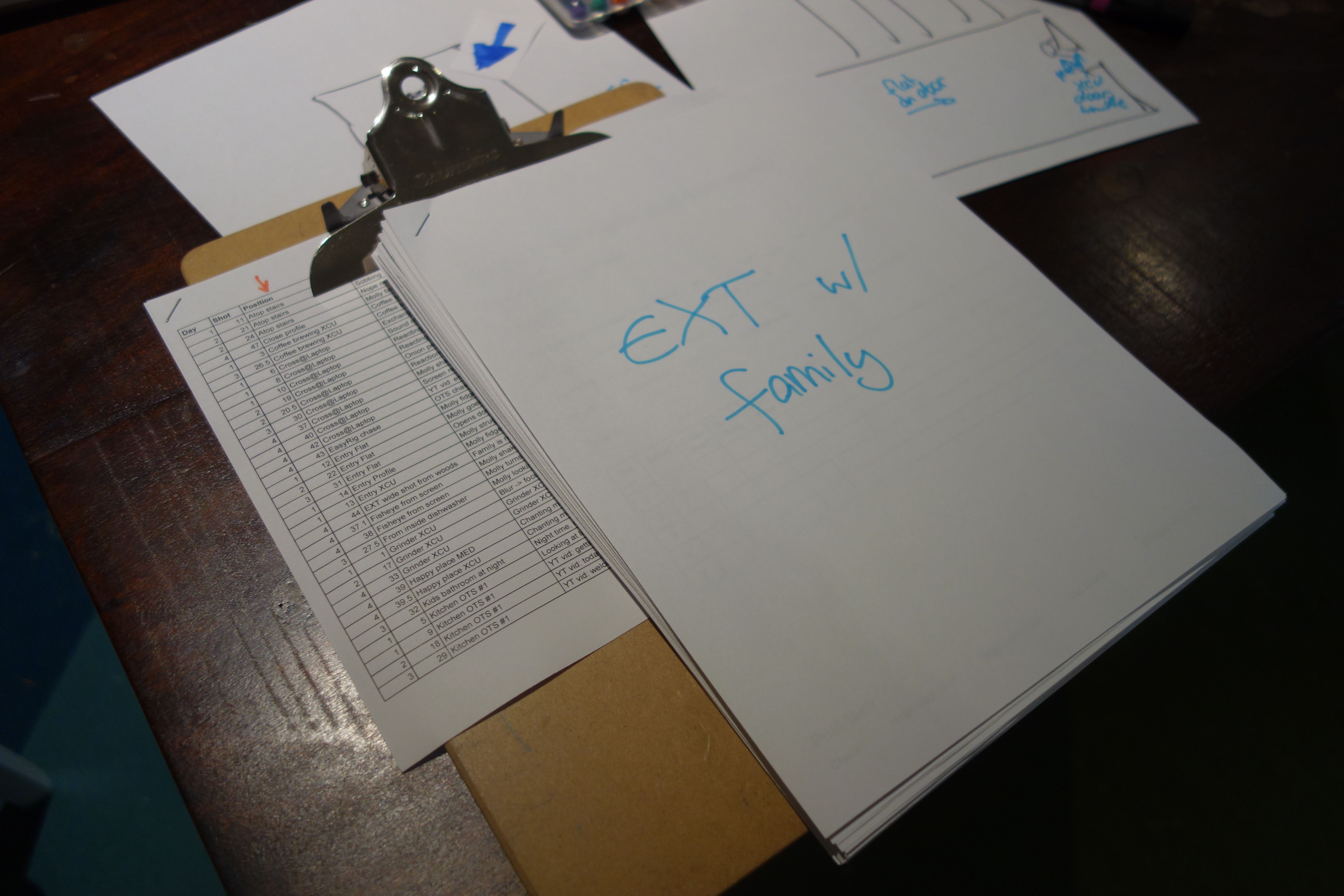
8:00am (35.5 hours remaining)
Robin is off to Target to get props (an onion, of course, and two identical coffee mugs), clothes for her to wear that we can get dirty and/or get blood on, and fixings for signs. She doesn't find any appropriate clothes so we just end up using what she wears in real life and do our best not to get it dirty.
Fun fact: The cat shirt Robin's character wears is what Robin wears in real life almost every day.
The Art Department a.k.a. Sarah is already feverishly at work crafting signs, setting up the Moonshadow Jones woo-woo room, pulling together the Moonshadow outfit, and so on.
Peter is clearing out and cleaning up all the spaces we'll be filming in.
9:00am (34.5 hours remaining)
Given that the production depends on our ability to greenscreen "YouTube" clips onto a laptop, it's time to learn how to greenscreen.
I grab some test footage of a laptop with a green screen - hilariously there are plenty of "10 hours of green" videos on YouTube you can play in full-screen mode to get a green laptop screen. This is also where my triple-monitor editing setup comes in super handy: two screens for DaVinci Resolve and one screen with a YouTube video telling me what to do. (This happens a lot.)
The greenscreening works like a charm - it's completely undiscoverable like most features in Resolve, but hey, it works. I get to breathe a short sigh of relief and grab a cup of coffee.
10:00am (33.5 hours remaining)
We entertain ourselves by getting some blood whipped up - one syringe for faster-flowing and one for goopier blood. Cash'n'Carry is a beautiful place for bulk corn syrup and food color purchases...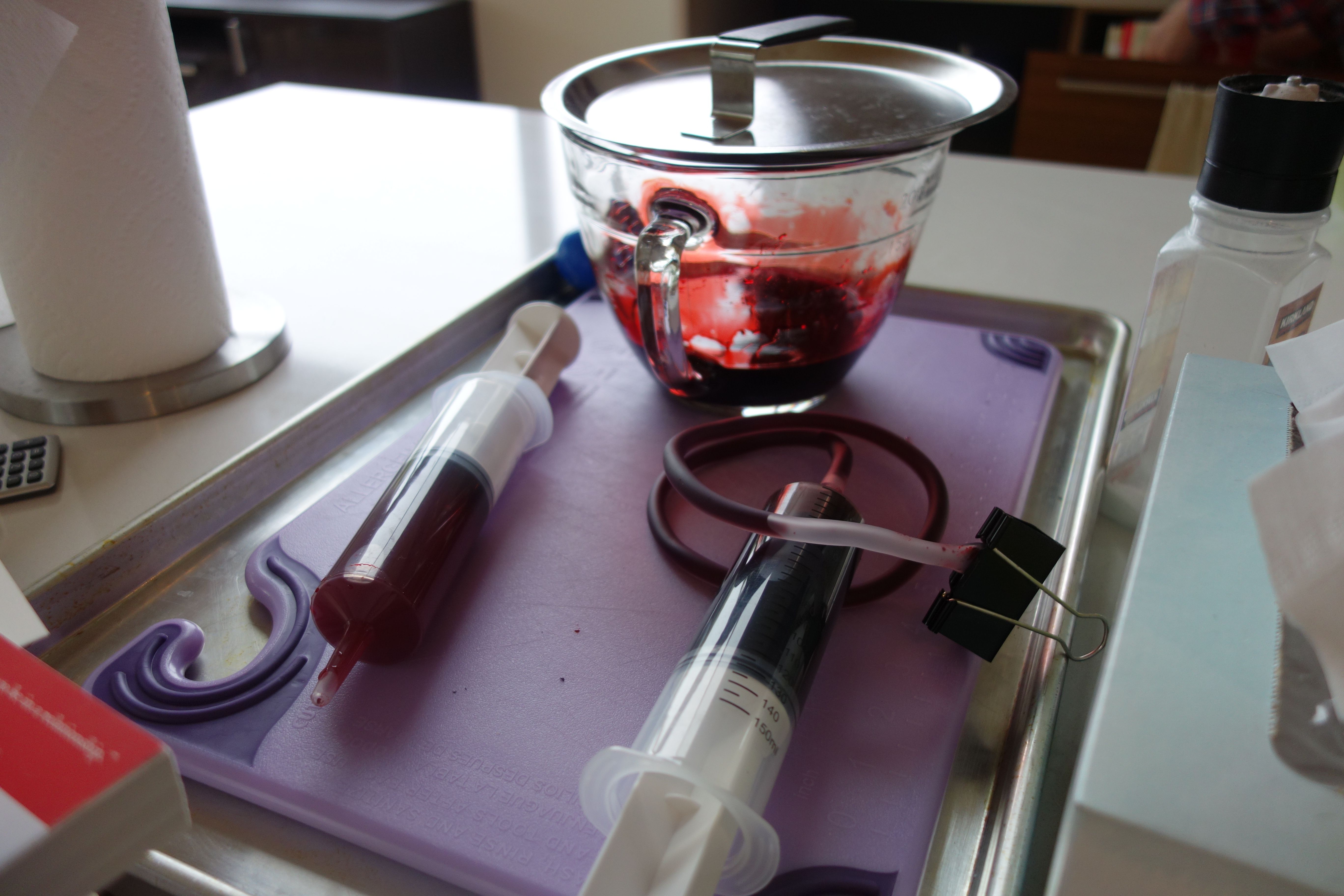
11:00am (32.5 hours remaining)
The Drummond clan shows up for our exterior scenes. We've decided to film our exterior scenes first, followed by the exterior-adjacent scene in the hallway, just to make sure there's enough daylight.
We're not ready on props yet and the Drummond clan chips in. I'm putting together the exterior camera setup. Of course it starts drizzling so I have to put a tent over the gear. Good times.
12:00pm (31.5 hours remaining)
We start shooting. The takes are blessedly fast. Sarah wrangles the crowd like the pro she is. Peter wrangles the dog.
1:00pm (30.5 hours remaining)
We dismiss the Drummond clan and film the remaining exterior shots that don't require the extras.
It turns out that having someone run and trip in heels safely isn't easy. We ended up building a crash pad using an air mattress and a mattress topper. Numerous takes later we have some pretty great footage. Robin puts on and takes off makeup for the first of many times today.
3:00pm (28.5 hours remaining)
We film the hallway chase scene. Having my ~10lb camera rig hanging off the Easyrig vest is better than nothing but it sure doesn't make for stable shots. Time to learn how to shuffle on the quick. We do about ten practice runs and then ten real takes.
4:00pm (27.5 hours remaining)
We start filming in the kitchen with our one two-camera setup for the day (thank you again Russell!). Having a wireless and movable client monitor for our A-Cam makes it pretty convenient to see what both cameras are doing from one location. The Bluetooth feature in the Blackmagic Design cameras is enraging because it's so effective when it works but the connection keeps breaking so some of the takes are mislabeled in the metadata. Most of the shots, though, get started and stopped over Bluetooth and we bust out take after take.
Quick technical note: Before this weekend I compared the sound quality of my camera's (BMPCC6K) mic input to the mic input of my stand-alone Zoom recorder. It turns out my shotgun mic sounds better on the camera's input than the Zoom so that frees me from having to babysit yet another device while recording. The Blackmagic cameras' built-in slates (well, metadata entry at any rate) and absence of any external sound recorder means I don't need to slate anything so that saves a bunch of time; I still shout out the scene and take number at the beginning of each shot just in case.
Sarah is coaching Robin through the reactions she wants to see to what Sarah will later be saying in the "YouTube" videos on the laptop that Robin is watching. The finished film looks more or less like they were real reactions but it's really just good directing, acting, and some editing.
It's getting later and the lighting needs constant adjusting. I gambled that we'd get through it fast enough to get to use ambient light with just some makeup artificial light. The gamble did not pan out.
6:30pm (25 hours remaining)
We briefly amuse ourselves by filming the scene where Robin looks for her mug in the dishwasher. This wasn't what I had anticipated when I bought the wireless HDMI transmitter for my camera but boy howdy is it useful here. Nothing like sticking thousands of dollars of electronics into a dishwasher.
We also hit the three Ed Wright-style inserts (coffee grinding, mug getting picked, coffee brewing). It's not a bad idea to film a shot involving coffee grounds - might as well drink more.
7:00pm (24.5 hours remaining)
We're filming the entry scenes (i.e. the stuff by the front door). Visually, this is supposed to be bright and early morning. It is 7pm and it's completely dark. Good times.
Sarah makes an uncredited appearance as a random delivery person who drops a package at the front door.
Peter keeps moving equipment from us as we travel from setup to setup. He is a saint.
9:00pm (22.5 hours remaining)
We film the bathroom scene where a ghost (well, Moonshadow) appears in the window (first seen through the mirror, then whip-panned over and back again). This involves a bunch of adventurous clowning around outside to set up a light powerful enough to backlight Sarah as well as a ladder setup so she's sufficiently high off the ground.
The inside is lit entirely with practicals: Robin's LED candles from her study.
The scene is a bit challenging to film because my brain is starting to fade and I'm having a hard time communicating what I want people to do when (freeze, appear, unfreeze, see, turn, ...).
Sarah is outside, Robin and I are inside, so we kind of have to shout at each other through a barely tilted window.
10:00pm (21.5 hours remaining)
We film the "happy place" scene where Robin's character recovers from a traumatic moment. We end up using our powder room for this so it's got silly posters on the wall, but why not.
10:30pm (21 hours remaining)
We knock out the shots in Sarah's bedroom which we're using as Robin's (Molly)'s bedroom. I finally get to use my dolly and Harry finally gets a job as the dolly op. I get to chill on an apple box on the dolly after a long day's work while he trucks me back and forth. Kids are great.
11:00pm (20.5 hours remaining)
We start filming Moonshadow Jones' scenes downstairs. Sarah's been thinking about ideas and jokes and lines all day (like the "arm breathing" thing) so she's well prepared. It still takes two hours with Robin and I consulting/semi-directing.
1:00am (18.5 hours remaining)
We find our last wind of the day and film the three shots for the "getting dressed montage". I was going to be too tired but then decided it would really tie the room together so we get it done.
1:30am (18 hours remaining)
We have filmed 50 shots, 156 takes, and shot 220GB of footage.
Time to sleep.
Sunday, October 18th 2020
5:30am (14 hours remaining)
It's time to import footage and get everything in Resolve organized. I flag takes as "good" (green) and "has color card" (purple) and mark in/out points.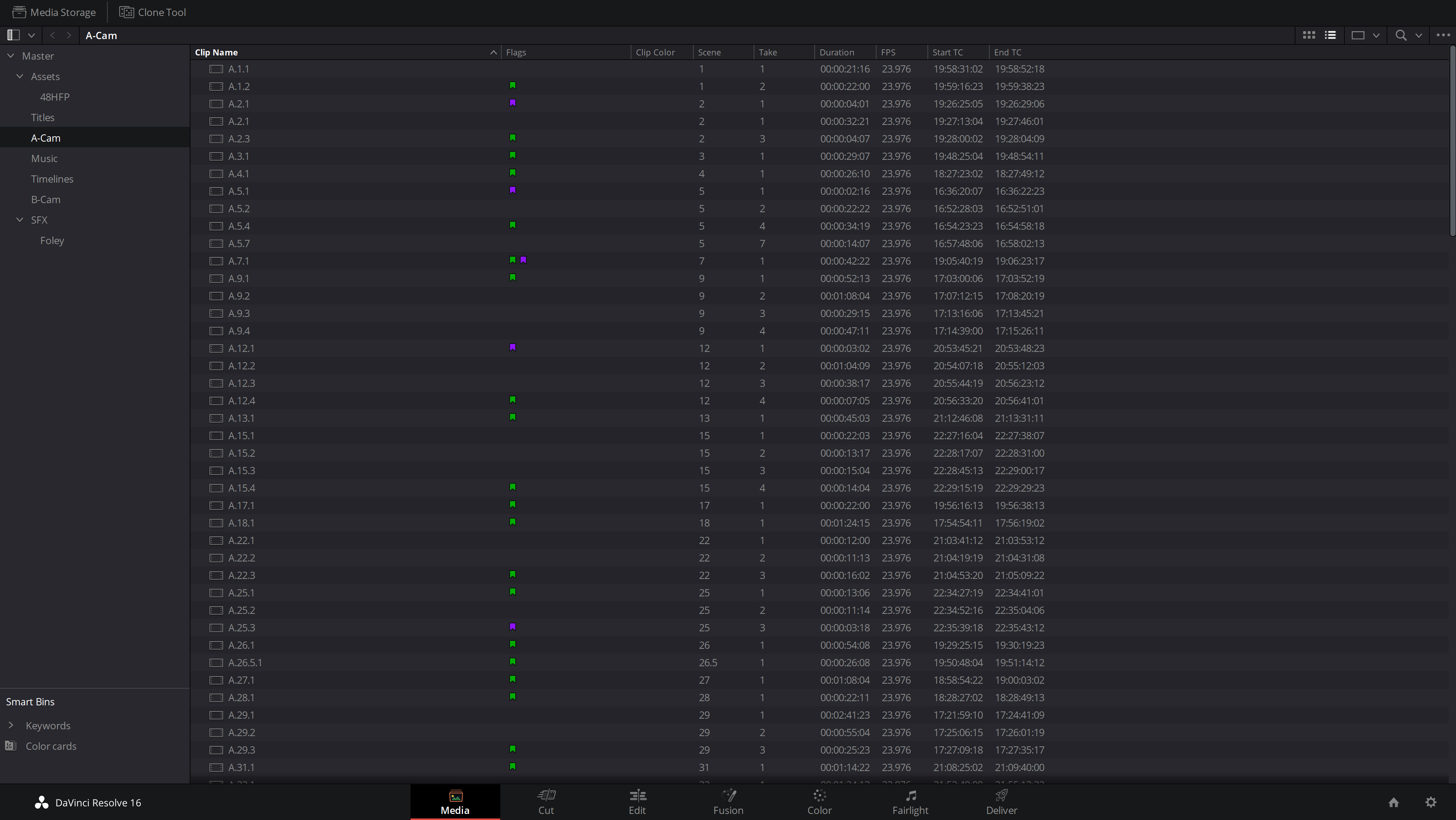
8:00am (11.5 hours remaining)
More coffee. I put together the "flossy ghost" sequence in its own timeline, that is, the scene of the ghost of Moonshadow Jones appearing in the bathroom window while Molly is flossing. It's really amazing what you can do just with retiming clips and good cuts and dissolves.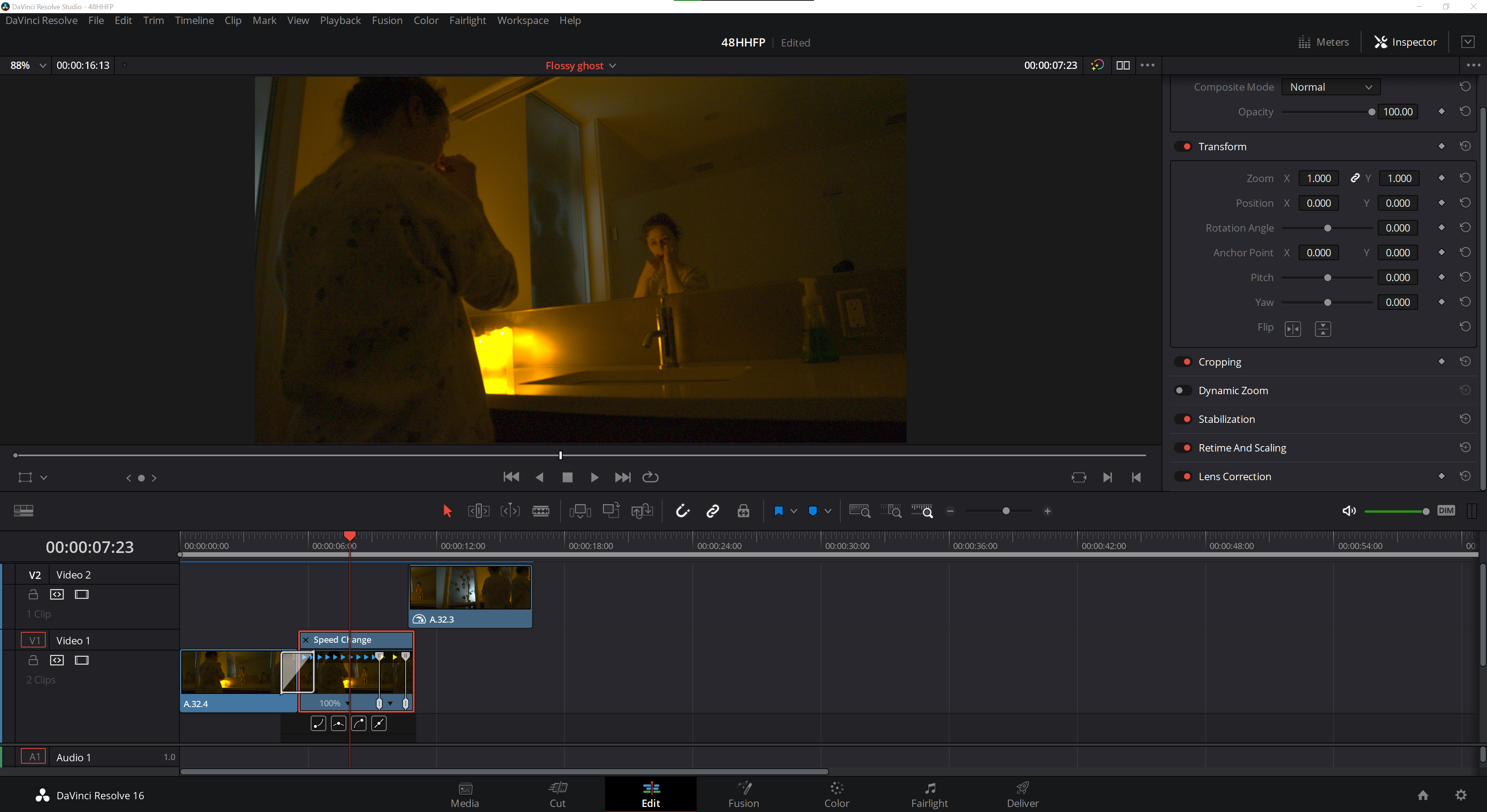
I work on getting some of greenscreening to work and blessedly it all works out fine.
10:00am (9.5 hours remaining)
Sarah and I start working together on the rough cut.
Going into the 48 I was concerned that we'd struggle to invent enough plot to make a film that's at least four minutes long. Now I'm sweating the maximum instead - it can't be more than seven minutes (plus credits).
This is where I make the greatest mistake of the weekend (relatively speaking): I decide not to learn on the fly how Resolve's multi-cam support works; instead, I treat the two camera angles for the kitchen scene as independent clips. This will make audio sync really challenging since audio only went into A-Cam, not B-Cam. Bad choice.
After an hour we realize that our rough cut is just going to be the final cut so we allow ourselves a bit more time tweaking edits to get it right the first time.
2:00pm (5.5 hours remaining)
We have a cut we're happy with. It's time to get all the greenscreening fully aligned and deal with assorted futz work.
3:00pm (4.5 hours remaining)
Time to work on sound. A few clips require special treatment with RX8 which is just a magical godsend of a tool. Thankfully bouncing to external processes is really easy in Resolve.
A lot more RX8'ing could have happened than I had time for so we slap in some random room tone off Artlist to bridge the worst of the gaps.
I separate each character's audio into their own audio track (makes EQs, effects, and mixing easier). This is where I make the second-greatest mistake of the weekend (again, relatively speaking): I haven't figured out that there's a magical setting in Resolve (Timeline > Linked Move Across Tracks) that lets me, well, move audio clips across tracks without unlinking them. Absent this knowledge I unlink all the audio tracks from all the video tracks (which means that any video edit change no longer moves the audio correctly) and "save myself the time" of re-linking them.
This is super dangerous and bites me in the ass about an hour before we need to do our final render and I need to scramble to restore A/V sync by ear. Not relaxing.
Thankfully I've spent some time playing with Fairlight (the audio part of Resolve) so it's fast to build out tracks and buses, adjust EQ and dynamics on the tracks, and manage stereo imaging on the buses with Izotope's wonderful and free Ozone Imager.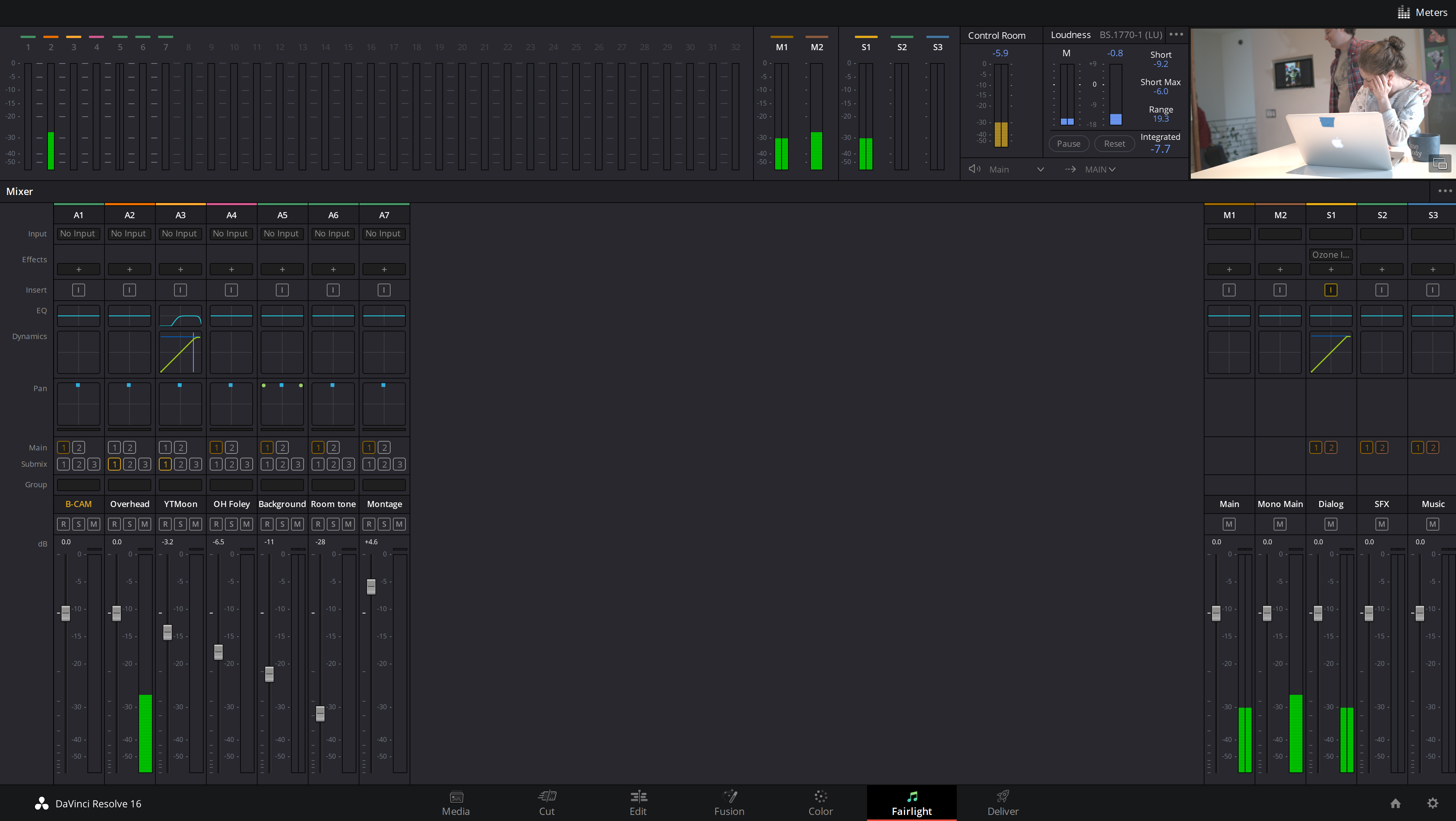
At this point it has become clear that I will not be making a score for this joint.
5:00pm (2.5 hours remaining)
Sarah is off looking through Artlist for sound effects which I edit in and mix as she finds them and I have time.
At this point it is also clear that I will not be doing any meaningful color grading for this joint. Everything you see in the 48 submission is straight from camera (no LUT, just a basic BMPCC6K->Rec709 transform) with the exception of some oranging in the night time scene: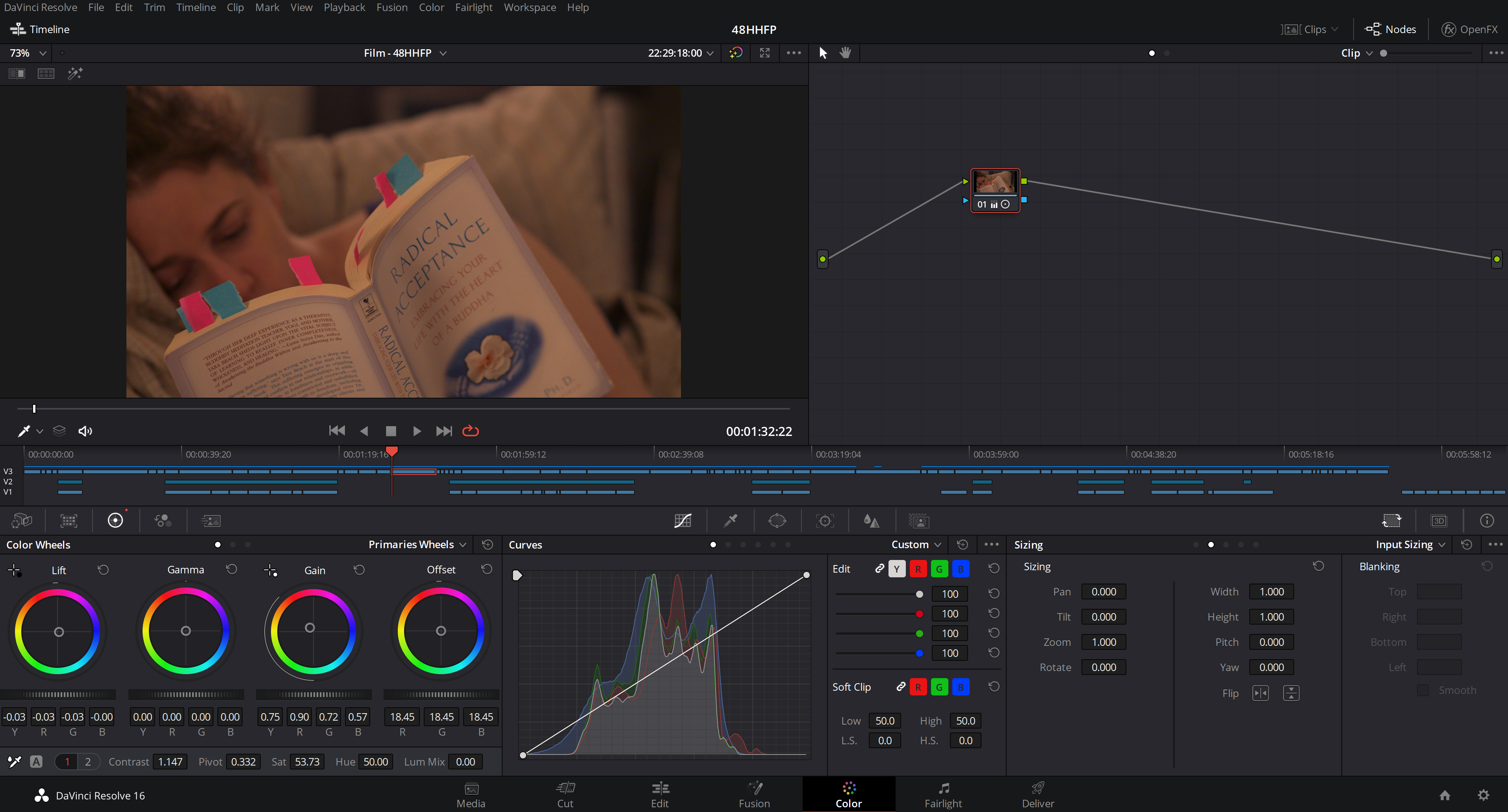
6:45pm (45 minutes remaining)
I start the final render and do a final proof with Sarah.
Here's the finished timeline: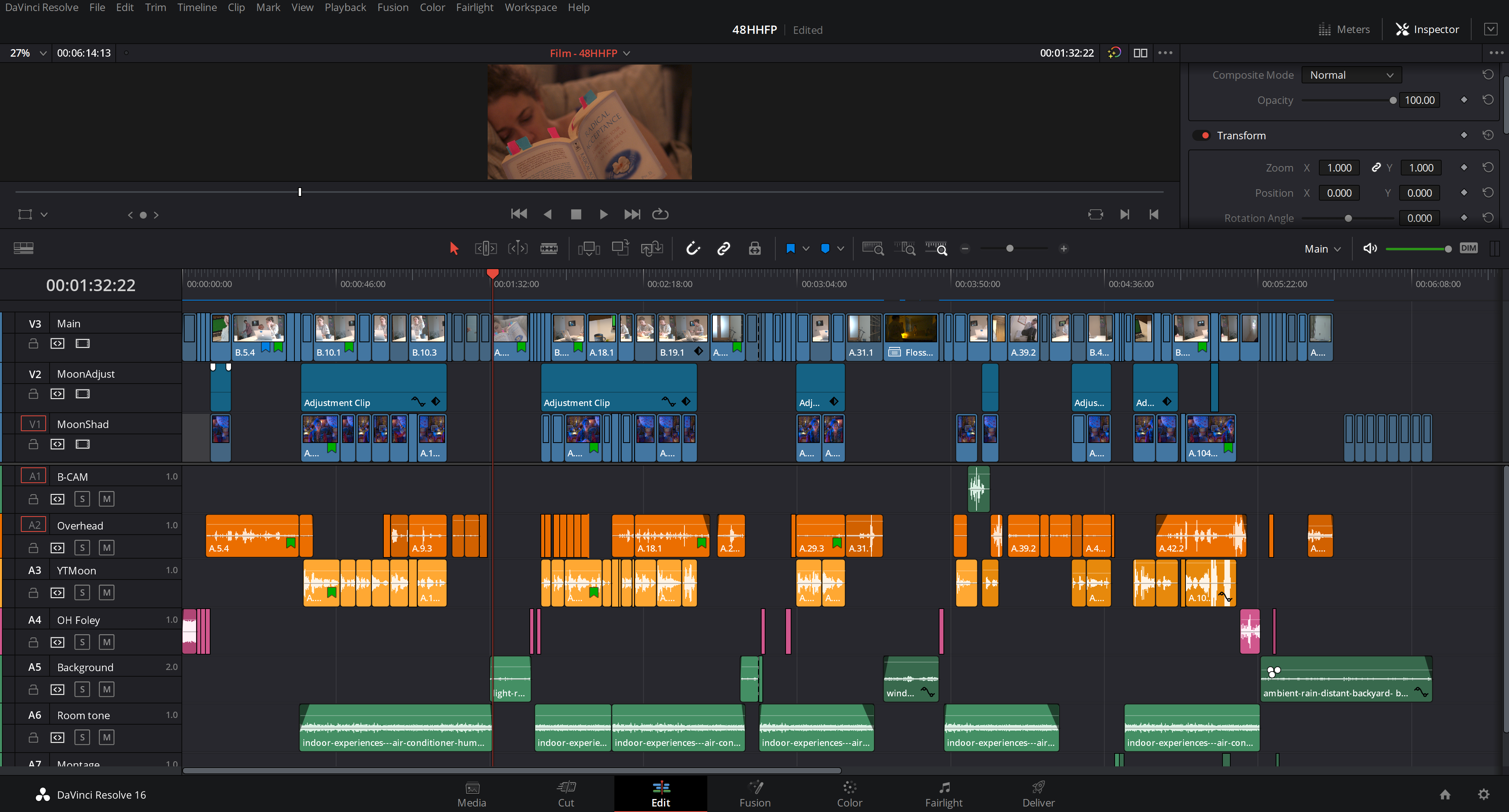
7:00pm (30 minutes remaining)
I start uploading. The site we're supposed to upload to is experiencing some growing pains but it gets there. For some reason we have to fill out some "how was your experience?" survey before we're able to upload. I am not in the mood for this.
7:15pm (15 minutes remaining)
The upload has completed and we're officially done with everything due by the deadline.
Time to finish the festival paperwork.
8:30pm
I've finished uploading all the paperwork (permissions, releases, licenses, ...) that is due by midnight. We are done.
November 2020
I work on the score.
Writing a score in Ableton Live is not a great idea. It's my favorite sequencer but its support for video is based on tech that was end-of-life'd a decade ago. It takes me several hours just to be able to see the video I'm trying to score to - this was never going to happen during the festival. I did try this all before the 48 but had somehow found a small successful corner case that did not work under real use. If anyone needs help, I've written up how I got it to work on Reddit.
The score ends up being fairly minimal because the movie already worked surprisingly well without any score so I didn't see any use in messing with that a lot.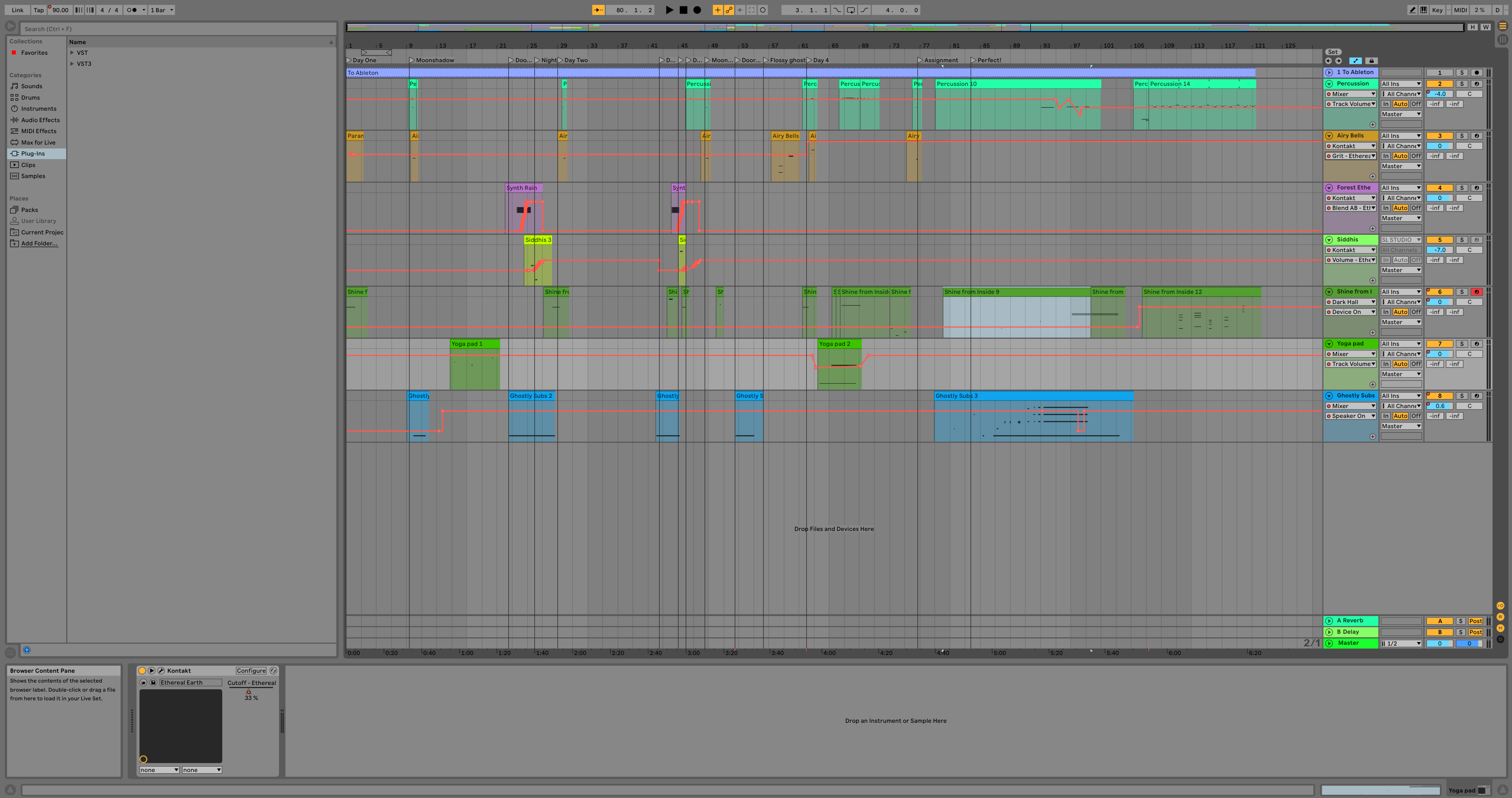
The instruments are mostly from Native Instruments' Arkhis and Ethereal Earth with a bit of their Orchestral Percussion thrown in. They're fantastically playable and controllable instruments with a good X/Y stick on any keyboard.
Because I'm lazy it's all in the key of C. Turns out the coffee grinder is exactly in B so I could quickly lift it up a semi-tone in Resolve and have it pitch-matched to the score.
I've automated the tempo in Ableton to increase at the start of each narrative day; this makes the ominous wobbling of the sounds ever so slightly faster the worse things get for our protagonist. Will anyone ever notice? Probably not, but now you know!
I also work on cleaning up more sound in the edit. I collect a bunch of foley with my slightly questionable Zoom recorder (like the dishwasher door squeaking) and it makes the whole thing much smoother.
Balancing sound along the length of the movie also isn't easy, especially since you're balancing both for levels and loudness (yes they're different, it's weird).
Many thanks to Alex Knickerbocker's YouTube channel for teaching me a lot of this, as well as DaVinci Resolve's excellent training videos.
December 2020
I work on color. I now simultaneously know a lot about color (luma vs. luminance, gamma, Log vs. Rec709 vs. Rec2020, primaries wheels vs. log wheels, ...) which really means I now also know that I know nothing (, Jon Snow). Good times.
Most of the effort goes into color correction (i.e. making each shot as accurate as it can be) and shot matching (making sure that shots from different times and angles look consistent). This is where the YOLO approach to lighting the kitchen scenes costs a lot of time in post: making various shots taken while the sun was going down look continuous is a pain.
Everything looks a bit more grown-up now. Each shot has a node pipe for color correction: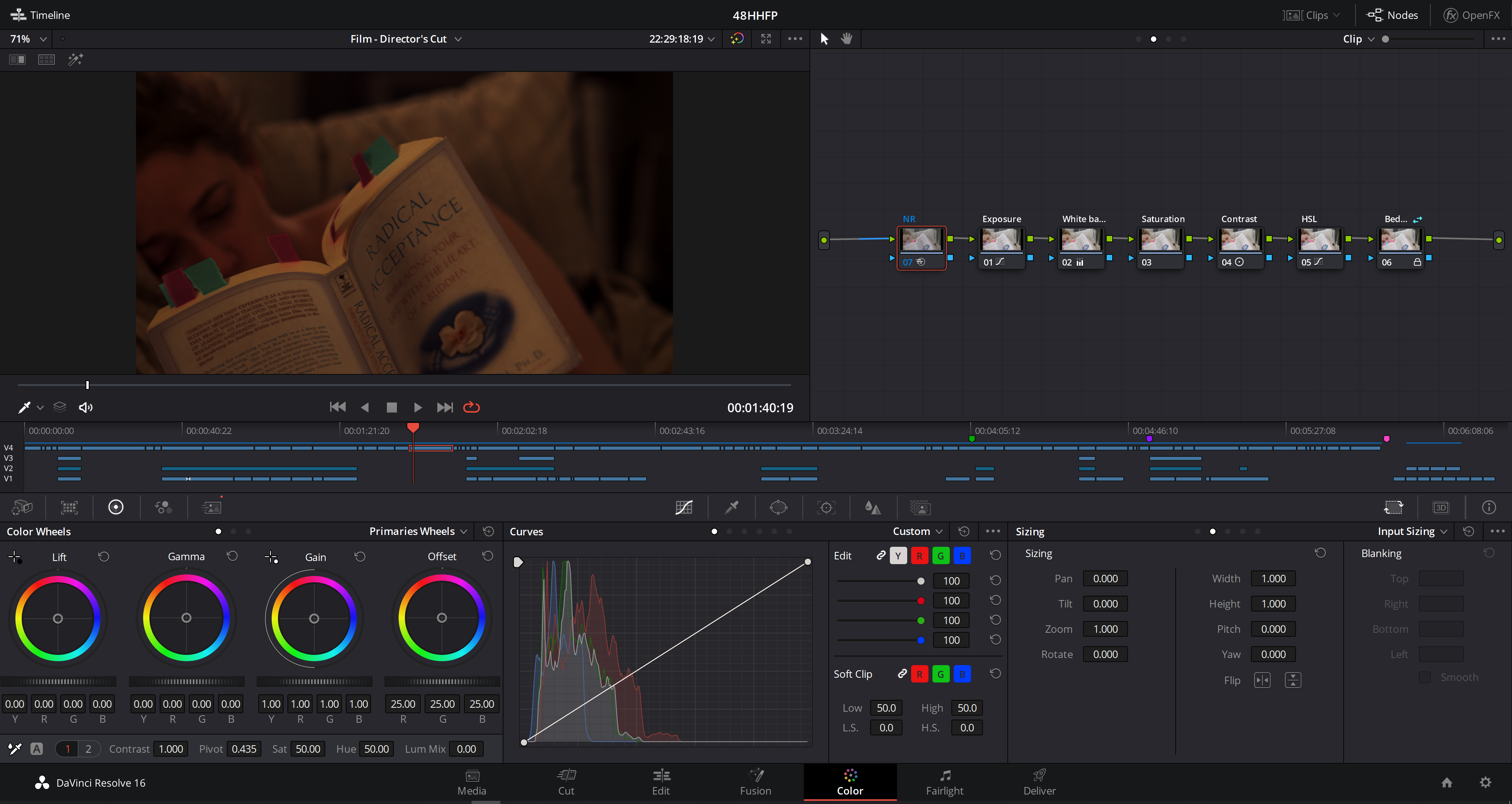
Each setup (e.g. Kitchen A-Cam vs. Kitchen B-Cam) has a shared node for matching to other shots in its family. Each family of shots (all the kitchen stuff, all the entry stuff, ...) lives in a group and that's where the color grading (the "artistic" look development happens):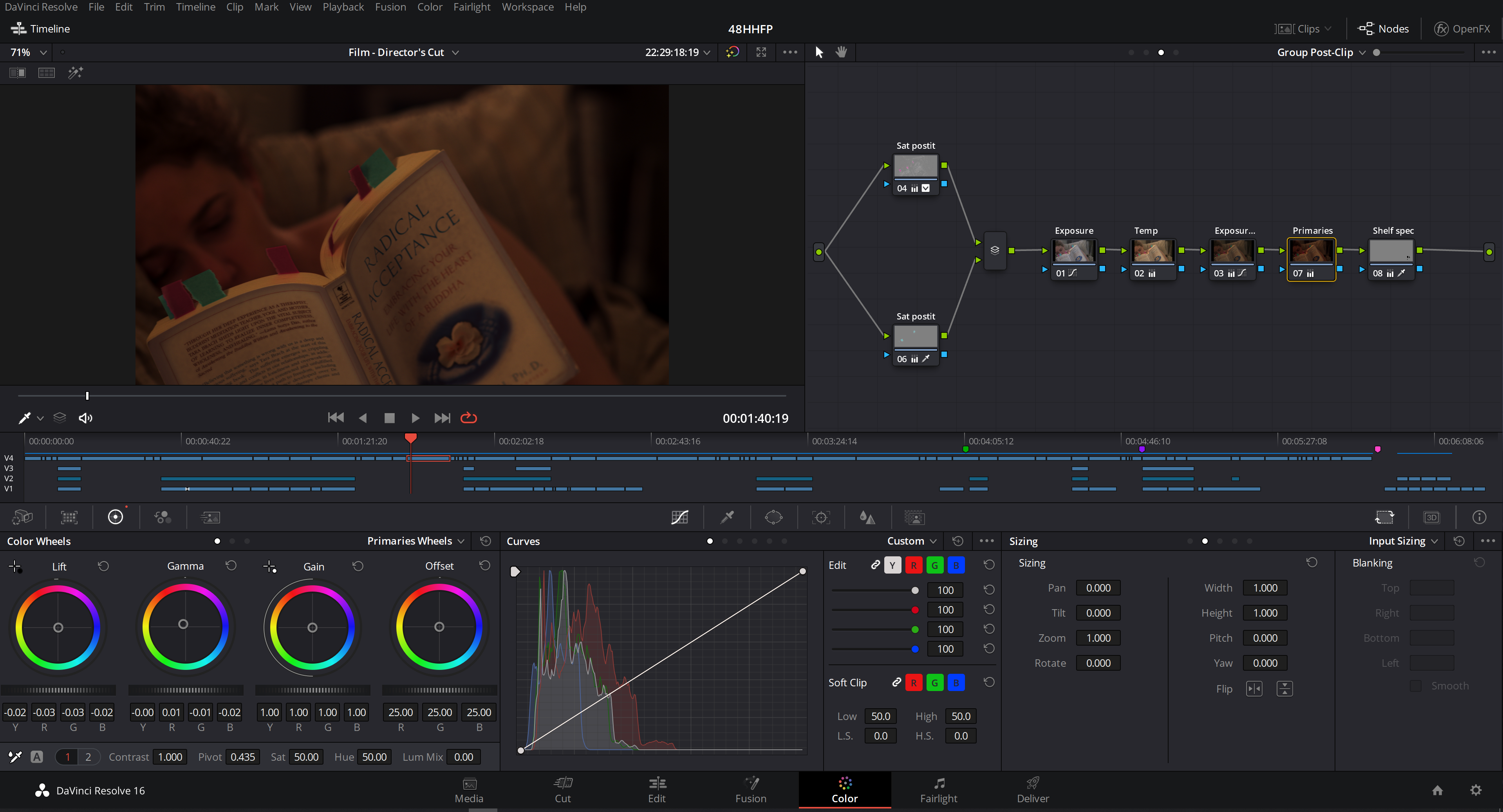
This particular one is actually pretty funny because for a realistic vibe we'd added some post-it notes to the books Robin's character was reading. Well, they popped like crazy and wrecked the mellow night-time vibe so their colors needed to be Qualifier'd and toned wayyyy down. Thankfully Resolve has a bunch of beautiful tools for this.
I'm happy with the work I was able to do on the color correction (the engineering work, if you will) but I can't say I'm happy with the grading (the artistic portion) just yet. I am happy with how much I learned so I'm calling it good at that.
Many thanks to Gerald Undone's YouTube channel for teaching me a lot of this, as well as (again) DaVinci Resolve's excellent training videos and free e-books.
It's a wrap
This was an amazing experience. As a perfectionist I was extremely reticent to do something like this, and I'm eternally grateful to Sarah for convincing me to get on with it.
A lot more got done in those 48 hours than in the six weeks after and as much as I love this project I'm also glad to be done with it. Next time (and I do think there'll be a next time) I'm not going to touch it again after the first 48 hours...
Many thanks to Sarah and Robin for their support and enthusiastic, unbridled participation. This was just so much better than I ever thought it would be.
Many thanks to Peter for all his help, and the Drummond clan for taking our kids for the first night, helping out during the second day, and all the small pickup work they helped with.
It was surprisingly magical to do this with a tiny crew. While it kept us from having the time to work on music or color (this time!), it meant that a lot less needed to be written down because there were really only so many heads to keep in sync. The power of small teams is real, y'all.
Bloopers
Here's your reward for reading this far:
| « NVMe clamp for camera rig | DWELL on your anxieties » |